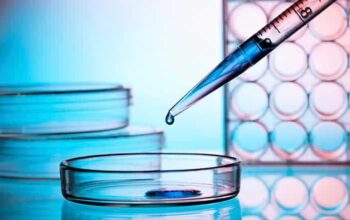The intersection of physics and microbiology has produced a myriad of groundbreaking innovations, particularly in sterilization techniques and pathogen control. One of the most salient developments is the application of electron beams (e-beams) to combat harmful microorganisms, including the notorious Escherichia coli (E. coli). E. coli is a Gram-negative bacterium that exists in various strains, some of which are pathogenic and known to cause significant gastrointestinal diseases in humans. The utilization of e-beam technology as a decontamination method represents not only a triumph of physical science but also a promising shift in microbial management and food safety protocols.
At its core, e-beam technology exploits the fundamental principles of electron physics. Energetic electrons, accelerated to high velocities, generate a highly energetic beam capable of penetrating biological tissues, including bacterial cells. This phenomenon is predicated on the ionization potential of the electron, which allows it to disrupt molecular structures within cells. As the electrons interact with microbial membranes, they induce ionization, leading to lethal damage in the cellular integrity of pathogens.
The mechanism through which electrons incapacitate E. coli hinges on a couple of pivotal processes: direct and indirect ionization. Direct ionization occurs when the electron beam physically displaces electrons from atoms within the microbial cells, leading to the formation of free radicals and subsequent cellular damage. Indirect ionization, conversely, results from the interaction of electrons with water molecules, creating reactive oxygen species. These reactive intermediates, such as hydroxyl radicals, further exacerbate the damage inflicted on cellular components, including DNA, proteins, and lipids.
In the context of food safety, the potential for e-beam sterilization to mitigate the risks posed by pathogenic E. coli is particularly noteworthy. Traditional sterilization methods, such as heat treatment or chemical disinfectants, often fall short due to variations in temperature tolerance and functional efficacy against anaerobic organisms. E-beam technology offers a non-thermal approach capable of inactivating a wide spectrum of microorganisms while preserving the organoleptic properties of food products. This characteristic is invaluable for the agro-food industry, where consumer preferences increasingly favor minimally processed, fresher foods that retain their nutritional integrity.
Moreover, the deployment of e-beam technology embraces an eco-friendly ethos, minimizing the reliance on harmful chemical agents. Conventional disinfectant methods may introduce residues that can be detrimental to both human health and the environment. In contrast, electron beam applications facilitate a stringent sterilization process without the generation of toxic by-products, thus offering an environmentally sustainable alternative.
Research substantiates the efficacy of e-beam technology against E. coli, demonstrating significant reductions in microbial load on various food matrices, including meat, dairy, and produce. For instance, studies have indicated that exposing E. coli to e-beams at specified dosimetric levels can achieve up to a 99.9999% reduction in viable cell counts, effectively transforming hazardous food products into consumable goods. This capability not only enhances food safety but also augments the shelf-life of products, as microbial spoilage is undermined.
Despite its promising attributes, the integration of e-beam sterilization into mainstream practice encounters several challenges that must be addressed. First, the capital investment required for the acquisition and maintenance of e-beam facilities can be substantial, creating a barrier to entry for smaller food processing entities. Additionally, regulatory approvals for novel sterilization methods often entail protracted timelines and rigorous evaluations, which can hinder widespread adoption. Nonetheless, proactive engagement between scientists, industry stakeholders, and regulatory agencies could pave the way for the broader acceptance of e-beam technology.
As investigations into e-beam technology continue, burgeoning research aims to elucidate the mechanistic intricacies underlying microbial inactivation and to identify optimal parameters for dosage and exposure times, tailored specifically for E. coli and other pathogens. Scientific inquiry is further augmented by technological advancements in electron accelerator design, which have catalyzed improvements in cost efficiency, safety, and operational efficacy.
The collision of physics and microbiology through the lens of electron beam technology not only sheds light on innovative sterilization techniques but also amplifies a cautiously optimistic narrative about future food safety strategies. This novel approach engenders a paradigm shift, inviting researchers and practitioners alike to reconsider traditional sterilization methodologies while stimulating curiosity about the profound interdependence of disciplines in addressing global health challenges.
In conclusion, the application of e-beam sterilization against E. coli epitomizes the advancing frontiers where physics influences practical solutions to biological dilemmas. As further empirical studies unfold and technological refinements emerge, e-beams hold the potential to revolutionize how society confronts the perils of pathogenic threats in the food supply chain. By embracing the union of scientific inquiry and technological innovation, the quest for safer and more sustainable food systems can be significantly bolstered through cutting-edge methodologies that redefine our approach to pathogen control.










